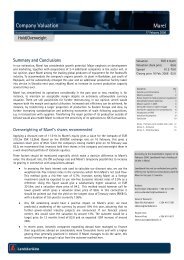Ársskýrsla Landsbankans - Landsbankinn
Ársskýrsla Landsbankans - Landsbankinn
Ársskýrsla Landsbankans - Landsbankinn
You also want an ePaper? Increase the reach of your titles
YUMPU automatically turns print PDFs into web optimized ePapers that Google loves.
Notes to the Consolidated Financial Statements<br />
3. Significant accounting policies (continued)<br />
Deferred income tax<br />
Deferred tax assets are recognised when it is probable that future taxable profit will be available against which deductible temporary differences can<br />
be utilised.<br />
Deferred income tax is recognised in full as a liability, based on temporary differences arising between the tax bases of assets and liabilities and their<br />
carrying amounts in the consolidated financial statements. However, deferred income tax is not recognised if it arises from the initial recognition of<br />
an asset or liability in a transaction other than a business combination, which at the time of the transaction affects neither the Group's accounting<br />
nor its taxable profit or loss. Deferred income tax is determined using tax rates (and laws) that have been enacted or substantially enacted by the<br />
reporting date and are expected to apply when the related deferred income tax asset is realised or the deferred income tax liability is settled.<br />
The principal temporary differences arise from fair value changes in various financial assets and liabilities and the difference between the fair values<br />
of acquired assets and their tax base.<br />
Assets and liabilities classified as held for sale<br />
The Group classifies non-current assets (or groups of assets together with related liabilities) as held for sale when their carrying amount will be<br />
recovered principally through a sale transaction. This is usually the case with collateral foreclosed by the Group which it holds as security for loans<br />
and advances, including assets and liabilities of subsidiaries over which the Group obtains control through foreclosure of collateral and/or financial<br />
restructuring.<br />
A non-current asset (or group of assets together with related liabilities) is considered to be recovered principally through a sale transaction when the<br />
asset's sale is highly probable and it is available for immediate sale in its present condition, subject to ordinary and customary terms on the sale of<br />
such assets. Management must be committed to the sale and must actively market the asset for sale at a price that is reasonable in relation to its<br />
current fair value. A further condition is that the sale is expected to qualify for recognition as completed within one year from the date of<br />
classification.<br />
Assets and disposal groups classified as held for sale are measured at the lower of their carrying amount and their fair value less costs to sell.<br />
Additional net assets that become part of a disposal group, for example due to profits generated by the disposal group, increase the carrying amount<br />
of the disposal group but not in excess of the fair value less costs to sell of the disposal group as determined at each reporting date.<br />
In the case of single assets classified by the Group as held for sale the Group determines their fair value less costs to sell by reference to the current<br />
market price at each reporting date. In the case of subsidiaries classified as held for sale, the Group determines the fair value of disposal groups<br />
based on discounted cash flows methodologies. Costs to sell are deemed to be only the costs which are incremental and directly attributable to the<br />
disposal of the disposal groups, excluding finance costs and income tax expense.<br />
Deposits and secured bonds<br />
The Group’s sources of debt funding consist of deposits, loans from financial institutions and debt securities.<br />
When the Group sells a financial asset and simultaneously enters into an agreement to repurchase the asset or a similar asset at a fixed price on a<br />
future date ("repo"), this arrangement is accounted for as an amount due to financial institutions or the Central Bank, and the underlying asset<br />
continues to be recognised in the Group‘s financial statements.<br />
The Group classifies financial instruments as financial liabilities or equity instruments in accordance with the substance of the contractual<br />
arrangement and the definitions of a financial liability, a financial asset or an equity instrument.<br />
Deposits and borrowings are initially measured at fair value plus any directly attributable transaction costs. Subsequently, they are measured at their<br />
amortised cost using the effective interest method. The fair value of a financial liability with a demand feature such as a demand deposit, is not less<br />
than the amount payable on demand, discounted from the first date that the amount could be required to be paid.<br />
Contingent bond<br />
The contingent bond is a contingent obligation of the Bank to issue a bond to Landsbanki Íslands hf. on 31 March 2013 as an additional<br />
consideration for the assets and liabilities transferred from Landsbanki Íslands hf. on 9 October 2008. The issue of the bond and its nominal amount<br />
are contingent on the excess of the value of certain pools of assets, to be determined as at 31 December 2012, over the future value of the<br />
acquisition price of those assets as at 9 October 2008, subject to specified adjustments.<br />
The contingent obligation of the Bank is classified as a financial liability and measured initially at fair value. Subsequently, it is measured at fair<br />
value, with any resulting gain or loss recognised in the line item "Fair value change of contingent bond" in the income statement.<br />
NBI hf. Consolidated Financial Statements 2010 18<br />
All amounts are in ISK million<br />
118 Ársreikningur 2010 Allar upphæðir eru í milljónum króna



